
Concept explainers
(a)
Interpretation:
The most stable chair conformation of the given molecule is to be drawn in which a
Concept introduction:
According to VSEPR theory,
The most stable chair confirmation of disubstituted cyclohexane is the one in which the larger substituent occupies the equatorial position.
In disubstituted cyclohexane, the substituents which are on the same side are cis to each other whereas substituents which are on the opposite side of the ring are trans to each other. If there is more than one substituent attached, then the conformation in which maximum substituents are in equatorial position is favored and is the most stable. Substituents that are trans to each other in one chair conformation remain trans after the chair flip, whereas substituents that are cis remain cis to each other during the ring flip.
Answer to Problem 4.70P
The most stable conformation of the given molecule is:

Explanation of Solution
The given molecule is:
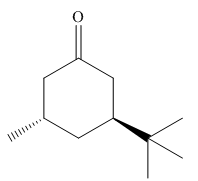
In the given molecule, there is a six member cyclic structure containing carbonyl group as a part of the ring. Thus, it is cyclohexanone. It has two substituents attached which are tertiary butyl group and a methyl group at C3 and C5 carbon atoms of cyclohexanone. Both substituents are trans to each other, as they lie on the opposite side of the ring. The tertiary butyl group is the bulkier substituent on the ring, and it is more stable in an equatorial position. Begin by drawing a chair conformation with a tertiary butyl group in an equatorial position. It is shown by a wedge bond, hence, it must point up in the chair conformation. The tertiary butyl group is pointed up and the methyl group must point down, for them to be trans, hence, the methyl group occupies the axial position as shown below:

If the chair is flipped, the equatorial tertiary butyl group becomes axial. The chair conformation having the bulkier tertiary butyl group in axial position is not stable. Hence, the most stable chair conformation of the given molecule is:

The most stable conformation of the given molecule has one substituent at equatorial position and another at axial position.
Interpretation:
The most stable chair conformation of the given molecule is to be drawn in which a
Concept introduction:
According to VSEPR theory,
The most stable chair confirmation of disubstituted cyclohexane is the one in which the larger substituent occupies equatorial position.
In disubstituted cyclohexane, the substituents which are on the same side are cis to each other whereas substituents which are on the opposite side of the ring are trans to each other. If there is more than one substituent attached, then the conformation in which maximum substituents are in equatorial position is favored and is the most stable. Substituents that are trans to each other in one chair conformation remain trans after the chair flip, whereas substituents that are cis remain cis to each other during the ring flip.
Answer to Problem 4.70P
The most stable conformation of the given molecule is:
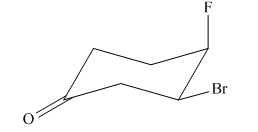
Explanation of Solution
The given molecule is:
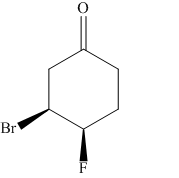
In the given molecule, there is a six member cyclic structure containing carbonyl group as a part of the ring. Thus, it is cyclohexanone. It has two substituents attached which are fluorine and bromine atoms at C3 and C4 carbon atoms of cyclohexanone. Both substituents are cis to each other, as they lie on the same side of the ring. Out of the two substituents, bromine atom is the largest substituent on the ring, and it is more stable in an equatorial position. Begin by drawing a chair conformation with bromine atom in equatorial position. It is shown by a wedge bond, hence, it must point up in the chair conformation. The bromine atom is pointed up and the fluorine atom must also point up for them to be cis, hence the fluorine atom occupies an axial position as shown below:

If the chair is flipped, the equatorial bromine atom becomes axial. The chair conformation having the bulkier group in equatorial position is more stable. Hence, the most stable chair conformation of the given molecule is:

The most stable conformation of the given molecule has one substituent at equatorial position and another at axial position.
(c)
Interpretation:
The most stable conformation of the given molecule is to be drawn.
Concept introduction:
According to VSEPR theory,
The most stable chair confirmation of disubstituted cyclohexane is the one in which the larger substituent occupies the equatorial position.
In disubstituted cyclohexane, the substituents which are on the same side are cis to each other whereas substituents which are on the opposite side of the ring are trans to each other. If there is more than one substituent attached, then the conformation in which maximum substituents are in equatorial position is favored and is the most stable. Substituents that are trans to each other in one chair conformation remains trans after the chair flip, whereas substituents that are cis remain cis to each other during the ring flip.
Answer to Problem 4.70P
The most stable conformation of the given molecule is:
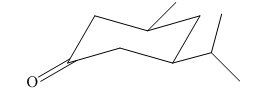
Explanation of Solution
The given molecule is:
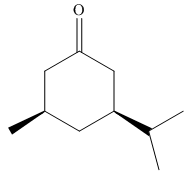
In the given molecule, there is a six member cyclic structure containing carbonyl group as a part of the ring. Thus, it is cyclohexanone. It has two substituents attached which are isopropyl group and methyl group at C3 and C5 carbon atoms of cyclohexanone. Both substituents are cis to each other as they lie on the same side of the ring. The isopropyl group is the largest substituent on the ring, and it is more stable in an equatorial position. Begin by drawing a chair conformation with isopropyl group in the equatorial position. It is shown by a wedge bond, hence, it must point up in the chair conformation. The isopropyl group is pointed up and the methyl group must also point up for them to be cis hence the methyl group goes to another equatorial position as shown below:

If the chair is flipped, both equatorial groups become axial. The chair conformation having the bulkier group in equatorial position is more stable. Hence, the most stable chair conformation of the given molecule is:

The most stable conformation of the given molecule has both substituents in equatorial position.
(d)
Interpretation:
The most stable conformation of the given molecule is to be drawn.
Concept introduction:
According to VSEPR theory,
The most stable chair confirmation of disubstituted cyclohexane is the one in which the larger substituent occupies the equatorial position.
In disubstituted cyclohexane, the substituents which are on the same side are cis to each other whereas substituents which are on the opposite side of the ring are trans to each other. If there is more than one substituent attached, then the conformation in which maximum substituents are in equatorial position is favored and is the most stable. Substituents that are trans to each other in one chair conformation remain trans after the chair flip, whereas substituents that are cis remain cis to each other during the ring flip.
Answer to Problem 4.70P
The most stable conformation of the given molecule is:
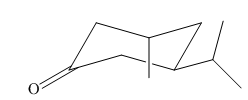
Explanation of Solution
The given molecule is:
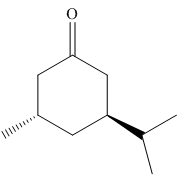
In the given molecule, there is a six member cyclic structure containing carbonyl group as a part of the ring. Thus, it is cyclohexanone. It has two substituents attached which are fluorine and bromine atoms at C3 and C4 carbon atoms of cyclohexanone. Both substituents are trans to each other, as they lie on the opposite side of the ring. Out of the two substituents, the isopropyl group is the largest substituent on the ring, and it is more stable in an equatorial position. Begin by drawing a chair conformation with isopropyl group in equatorial position. It is shown by a wedge bond, hence, it must point up in the chair conformation. The isopropyl group is pointed up and the methyl group must point down for them to be trans, hence the methyl group goes to axial position as shown below:

If the chair is flipped, the equatorial Isopropyl group becomes axial. The chair conformation having the bulkier group in equatorial position is more stable. Hence, the most stable chair conformation of the given molecule is:

The most stable conformation of the given molecule has one substituent at equatorial position and another at axial position.
(e)
Interpretation:
The most stable conformation of the given molecule is to be drawn.
Concept introduction:
According to VSEPR theory,
The most stable chair confirmation of disubstituted cyclohexane is the one in which the larger substituent occupies the equatorial position.
In disubstituted cyclohexane, the substituents which are on the same side are cis to each other whereas substituents which are on the opposite side of the ring are trans to each other. If there is more than one substituent attached, then the conformation in which maximum substituents are in equatorial position is favored and is the most stable. Substituents that are trans to each other in one chair conformation remain trans after the chair flip, whereas substituents that are cis remain cis to each other during the ring flip.
Answer to Problem 4.70P
The most stable conformation of the given molecule is:
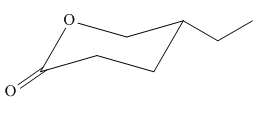
Explanation of Solution
The given molecule is:
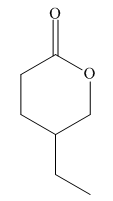
In the given molecule, there is a six membered cyclic structure containing ester group as a part of the ring. It has one substituent attached which is a ethyl group not shown by a wedge or dash bond. Thus, the ethyl group can be placed above or below the plane of the ring. The ethyl group is more stable at equatorial position than axial position. Thus, the most stable chair conformation of the given molecule is:

The most stable chair conformation of the given molecule has the bulkier substituent at equatorial position.
Want to see more full solutions like this?
Chapter 4 Solutions
ORGANIC CHEMISTRY PRINCIPLES & MECHANISM
- Design experiments in UV-Vis to figure the optimal mole ratio of copper (1:1, 2:1, 3:1 and etc)versus ethambutol using all necessary chemicals including dihydrochloride and copper nitrate hemipentahydrate and sodium hydroxide. Show how UV-Vis absorbance and maximum wavelength would change in responsearrow_forwardCorrect each molecule in the drawing area below so that it has the condensed structure it would have if it were dissolv a 0.1 M aqueous solution of HCI. If there are no changes to be made, check the No changes box under the drawing area. No changes. HO—CH,—C—CH,—OH X 5 2 2 2 HO–CH,—CH,—C—CH,—OH Explanation Check Center Accessi ©2025 on 5 Carrow_forwardMake the calculations to prepare 2M H2SO4, from concentrated H2SO4 (98%; density: 1.84 g/mL).arrow_forward
- H CH3 CH3 b) Write the products of your compound and the following reagents. If the reaction would not work for your compound, write "no reaction" and explain the problem. NaCN H* H₂NNHCH5 H* -à NaBH -à CH2MgBr Cro₁₂ --à H3O+ -à c) Would your compound give a positive Tollen's test? Why or why not?arrow_forwardHomework 4 Chem 204 Dr. Hellwig Consider this compound, which will be referred to as "your compound". a) Name your compound according to the IUPAC system. Include stereochemistry (E/Z/R/S) H CH3 CH3arrow_forwardWhat is the mechanism for this?arrow_forward
- 21.50 Determine the combinations of haloalkane(s) and alkoxide(s) that could be used to synthesize the following ethers through Williamson ether synthesis. (a) (c) (d) (e) (f) H₂COarrow_forward1. Arrange the following in order of increasing bond energy (lowest bond energy first, highest bond energy last). Provide your rationale. C=C, C-F, C=C, C-N, C-C List the bond order for each example.arrow_forwardWhat is the major enolate formed when treated with LDA? And why that one?arrow_forward
- 4. Calculate the total number of sigma bonds and total number of pi bonds in each of the following compounds. a. HH :D: +1 I H-N-C-C-O-H I H b. HH H Н :N=C-C-C=C-CEC-H :0: total o H-C-H H-C = `C-H I H. 11 H-C = C= CH H total o total π total π 1 Harrow_forwardIn the following reaction, what quantity in moles of CH₃OH are required to give off 4111 kJ of heat? 2 CH₃OH (l) + 3 O₂ (g) → 2 CO₂ (g) + 4 H₂O(g) ∆H° = -1280. kJarrow_forwardIndicate the processes in the dismutation of Cu2O.arrow_forward
 Organic Chemistry: A Guided InquiryChemistryISBN:9780618974122Author:Andrei StraumanisPublisher:Cengage Learning
Organic Chemistry: A Guided InquiryChemistryISBN:9780618974122Author:Andrei StraumanisPublisher:Cengage Learning Organic ChemistryChemistryISBN:9781305580350Author:William H. Brown, Brent L. Iverson, Eric Anslyn, Christopher S. FootePublisher:Cengage Learning
Organic ChemistryChemistryISBN:9781305580350Author:William H. Brown, Brent L. Iverson, Eric Anslyn, Christopher S. FootePublisher:Cengage Learning

